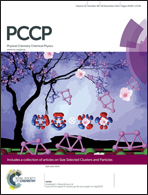More stable and more efficient alternatives of Z-907: carbazole-based amphiphilic Ru(ii) sensitizers for dye-sensitized solar cells†
Abstract
Here we report two novel amphiphilic Ru(II) heteroleptic bipyridyl complexes, HD-14 and HD-15, compared to previously reported NCSU-10. We have combined the strong electron donor characteristics of carbazole and the hydrophobic nature of different long alkyl chains, C7, C18 and C2 (NCSU-10), tethered to N-carbazole to study their influence on photocurrent, photovoltage and long term stability for dye-sensitized solar cells. Photon harvesting efficiency and electron donating characteristics of carbazole-based ancillary ligands were found to be unaffected by different alkyl chain lengths. However, a slight drop in the Voc of HD-14 and HD-15 was observed compared to that of NCSU-10. It was found by nanosecond flash photolysis transient absorption (TA) measurements that the faster the dye regeneration the higher the photocurrent density response, and the dye regeneration time was found to be 2.6, 3.6, and 3.7 μs for HD-14, HD-15, and N719 dyes, respectively. The difference in the amplitude of the transient absorption (TA) signal of the oxidized dye as measured by femtosecond TA studies is in excellent agreement with the photocurrent generated, which was in the following order HD-14 > HD-15 > N719. Under 1000 h light soaking conditions, HD-15 maintained up to 98% (only 2% loss) of the initial power conversion efficiency compared to 8% loss for HD-14 and 22% loss in the power conversion efficiency for NCSU-10. HD-15 was strikingly stable to light soaking conditions when employed in the presence of an ionic liquid electrolyte, which paves the way for widespread applications of dye-sensitized solar cells with long term stability. The total power conversion efficiency (η) was 9.27% for HD-14 and 9.17% for HD-15 compared to 8.92% for N719.


 Please wait while we load your content...
Please wait while we load your content...